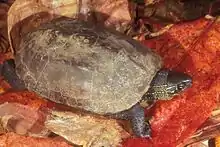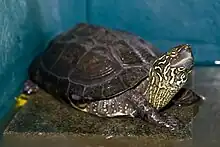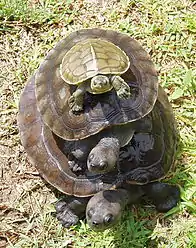Chinese pond turtle
Mauremys reevesii, commonly known as the Chinese pond turtle, the Chinese three-keeled pond turtle, or Reeves' turtle, is a species of turtle in the family Geoemydidae, a family which was formerly called Bataguridae.[2] The species is native to East Asia.
| Chinese pond turtle | |
|---|---|
 | |
| Mauremys reevesii in East Timor | |
| Scientific classification | |
| Domain: | Eukaryota |
| Kingdom: | Animalia |
| Phylum: | Chordata |
| Class: | Reptilia |
| Order: | Testudines |
| Suborder: | Cryptodira |
| Superfamily: | Testudinoidea |
| Family: | Geoemydidae |
| Genus: | Mauremys |
| Species: | M. reevesii |
| Binomial name | |
| Mauremys reevesii | |
| Synonyms[3] | |
|
click to expand
| |

It is one of the two most commonly found species used for divination that have been recovered from Shang dynasty sites.[4]
Geographic range
Mauremys reevesii is native to China and Korea, and is thought to have been introduced to Japan and Taiwan in historic times; it was previously thought to be native to both these regions. The species is thought to have been introduced to Japan from the Korean Peninsula near the end of the 18th century. Introduced populations of M. reevesii may serve as a threat to the native turtles of these regions due to its propensity for hybridization.[2][5][6][7]
Habitat and behaviour
M. reevesii is semiaquatic, and basks in the sun on rocks or logs and can often be found leaving water to do so. They can usually be found in marshes, relatively shallow ponds, streams, and canals with muddy or sandy bottoms.
Conservation status
The Chinese three-keeled pond turtle (M. reevesii) is threatened by competition with released pet red-eared sliders (Trachemys scripta elegans), overhunting (its plastron is used in traditional Chinese medicine),[8][9] capturing for the pet trade, and wild habitat destruction. The IUCN considers M. reevesii an endangered species.[5] This species, fortunately, breeds well in captivity.[7]
Etymology
The specific name, reevesii, is in honor of English naturalist John Reeves.[10]
Hybridization
This species, Mauremys reevesii, is notorious for its ability to produce hybrids with other Geoemydidae, even species that are only distantly related. The supposed new species "Mauremys pritchardi " was based on a hybrid of unknown origin between a male of this species and a female yellow pond turtle (Mauremys mutica). Furthermore, it has hybridized with the Chinese stripe-necked turtle (Ocadia sinensis), female Malayan box turtles (Cuora amboinensis), a male four-eyed turtle (Sacalia quadriocellata), and the Japanese pond turtle (Mauremys japonica) in captivity.[11][12] This hybridization may pose a threat to the populations of native M. mutica and Chinese stripe-necked turtle (M. sinensis) in Taiwan, and the endemic M. japonica in Japan.[7]
Any individuals that are available as pets therefore need to be kept separate from other members of the family.
Farming
High demand for turtle plastrons for Shang divination rites and archaeological findings of large caches of turtle shells has led some scholars to speculate that Mauremys reevesii may have been farmed for this purpose in antiquity.[13]
M. reevesii is one of the species raised on China's modern-day turtle farms. According to a 1998 survey, 548 farms raised this turtle species in four provinces in China. The statistical data from different provinces were in different formats; however, two provinces reported 20,650 turtles living on 26 farms, with 5,000 animals reproduced annually; the other two provinces reported the total weight of their turtles, namely some 260 tons of these animals on 522 farms. Over the five-year period, 1990–1995, 13 traditional Chinese medicine factories consumed 430 tons of C. reevesii plastrons.[14]
Based on a more recent (2002) survey of 684 Chinese turtle farms (less than half of all 1,499 turtle farms that were registered at the time), researchers found that 2.8 million of turtles of this species (reported there as Chinemys reevesii) lived on these farms, with some 566,000 specimens sold by farmers every year. The total weight of the annual product was 320 tons, with the estimated value of over US$6 million, which makes the market value of a Chinese pond turtle equal to around $12—about twice as much that of the most common farmed species, Pelodiscus sinensis. Taking into account the registered farms that did not respond to the survey, as well as the unregistered producers, the total amounts must be considerably higher.[15]
Pet trade
Chinese pond turtles are also farmed for the pet trade. In captivity, they require similar care to red-eared sliders (T. s. elegans).
East Timor
During surveys in East Timor (Timor-Leste), a small but well-established population of M. reevesii was found living in marshes near the city of Dili. The species is not native to the island and was possibly introduced by locals of Chinese origin.[16] East Timor is home to the Roti Island snake-necked turtle (Chelodina mccordi), more specifically the subspecies C. m. timorensis (sometimes considered a species of its own). Although the introduced population of M. reevesii is not known to present a risk to the native turtles per se, they could indirectly present a threat to the natives if confused. M. reevesii from the introduced population are sometimes captured to be sold to people of Chinese origin and this may cause problems if extended to the native turtles.[16] A potential solution is to remove the introduced M. reevesii (thereby restricting the trade to captive farmed M. reevesii).[16]
References
- van Dijk, P.P. 2011. Mauremys reevesii (errata version published in 2016). The IUCN Red List of Threatened Species 2011: e.T170502A97431862. https://dx.doi.org/10.2305/IUCN.UK.2011-1.RLTS.T170502A6783291.en. Retrieved 8 May 2020.
- Rhodin, Anders G.J.; van Dijk, Peter Paul; Iverson, John B.; Shaffer, H. Bradley (14 December 2010). "Turtles of the world, 2010 update: Annotated checklist of taxonomy, synonymy, distribution and conservation status" (PDF). Chelonian Research Monographs. 5: 000.112. doi:10.3854/crm.5.000.checklist.v3.2010. ISBN 978-0965354097. Archived from the original (PDF) on 17 July 2011.
- Fritz, Uwe; Havaš, Peter (2007). "Checklist of Chelonians of the World" (PDF). Vertebrate Zoology. 57 (2): 232–233. ISSN 1864-5755. Archived from the original (PDF) on 1 May 2011. Retrieved 29 May 2012.
- Keightley, David N. (1978). Sources of Shang history : the oracle-bone inscriptions of Bronze Age Chin (2 ed.). Berkeley ; London: University of California Press. p. 9. ISBN 0-520-05455-5.
- ATTWG (2000)
- Suzuki, Dai; Yabe, Takashi; Hikida, Tsutomu (December 2013). "Hybridization between Mauremys japonica and Mauremys reevesii Inferred by Nuclear and Mitochondrial DNA Analyses". Journal of Herpetology. 48 (4): 445–454. doi:10.1670/11-320. ISSN 0022-1511. S2CID 86411251.
- Rhodin, Anders G.J. (15 November 2021). Turtles of the World: Annotated Checklist and Atlas of Taxonomy, Synonymy, Distribution, and Conservation Status (9th Ed.). Chelonian Research Monographs. Vol. 8. Chelonian Research Foundation and Turtle Conservancy. doi:10.3854/crm.8.checklist.atlas.v9.2021. ISBN 978-0-9910368-3-7. S2CID 244279960.
- da Nóbrega Alves, Rômulo Romeu; da Silva Vieira; Washington Luiz & Gomes Santana, Gindomar (2008): Reptiles used in traditional folk medicine: conservation implications. Biodiversity and Conservation 17(8): 2037–2049. doi:10.1007/s10531-007-9305-0 (HTML abstract, PDF first page)
- Subhuti Dharmananda. "Endangered species issues affecting turtles and tortoises used in Chinese medicine".
- Beolens, Bo; Watkins, Michael; Grayson, Michael (2011). The Eponym Dictionary of Reptiles. Baltimore: Johns Hopkins University Press. xiii + 296 pp. ISBN 978-1-4214-0135-5. (Chinemys reevesii, p. 218).
-
- Parham, James Ford; Simison, W. Brian; Kozak, Kenneth H.; Feldman, Chris R. & Shi, Haitao (2001): New Chinese turtles: endangered or invalid? A reassessment of two species using mitochondrial DNA, allozyme electrophoresis and known-locality specimens. Animal Conservation 4(4): 357–367. PDF fulltext Archived 24 July 2008 at the Wayback Machine Erratum: Animal Conservation 5(1): 86 HTML abstract
- Buskirk, James R.; Parham, James F. & Feldman, Chris R. (2005): On the hybridisation between two distantly related Asian turtles (Testudines: Sacalia × Mauremys). Salamandra 41: 21-26. PDF fulltext
- Keightley, David N. (1978). Sources of Shang history : the oracle-bone inscriptions of Bronze Age Chin (2 ed.). Berkeley ; London: University of California Press. p. 12. ISBN 0-520-05455-5.
- GUO Yinfeng, ZOU Xueying, CHEN Yan, WANG Di & WANG Sung. "Sustainability of Wildlife Use in Traditional Chinese Medicine". 1998. Archived from the original on 10 July 2012. Retrieved 27 December 2009.; also quoted in: Subhuti Dharmananda. "Endangered species issues affecting turtles and tortoises used in Chinese medicine".
- Shi, Haitao; Parham, James F; Fan, Zhiyong; Hong, Meiling; Yin, Feng (1 January 2008), "Evidence for the massive scale of turtle farming in China", Oryx, Cambridge University Press, vol. 42, pp. 147–150, doi:10.1017/S0030605308000562
- Kaiser, Hinrich; Taylor, David; Heacox, Scott; Landry, Paul; Sanchez, Caitlin; Varela Ribeiro, Agivedo; Lemos de Araujo, Luis; Kathriner, Andrew; O'Shea, Mark (30 June 2013). "Conservation education in a post-conflict country five hematological case studies in Timor-Leste" (PDF). Salamandra. 49 (2). ISSN 0036-3375. Retrieved 18 January 2016.
Further reading
- Gray JE (1831). Synopsis Reptilium; or Short Descriptions of the Species of Reptiles. Part I.—Cataphracta. Tortoises, Crocodiles, and Enaliosaurians. London: Treuttel, Wertz, and Co. viii + 85 pp. (Emys reevesii, new species, pp. 73–74). (in English and Latin).

